Binary search tree
This is tree there every node have only two childs, left and right. Left node contain value less his vertex, right vertex contain value more that parent vertex.
AVL tree
AVL tree is a self-balancing Binary Search Tree where the difference between heights of left and right subtrees cannot be more than one for all nodes. If difference bitween heights is bigger, balancing should fix difference.
Node
For avl tree need to have the balance factor, it is difference between right and left heights.
class Node {
constructor({ key = 0, height = 1, left, right }) {
this.key = key;
this.height = height;
this.left = left;
this.right = right;
}
getBalanceFactor() {
const lHeight = this.left ? this.left.height : 0;
const rHeight = this.right ? this.right.height : 0;
return rHeight - lHeight;
}
fixHeight() {
const lHeight = this.left ? this.left.height : 0;
const rHeight = this.right ? this.right.height : 0;
this.height = (lHeight > rHeight ? lHeight : rHeight) + 1;
}
}
Balancing
Balancing of tree uses methods of left and right rotation.
Left rotation
Right child became new root
Node lose right child, and left child of old right child became new right child of the node
Old right child lose left child, and node became new left child of the new root
Right rotation
Left child became new root
Node lose left child, and right child of old left child became new left child of the node
Old left child lose right child, and node became new right child of the new root
Insertion
Insertion of new node
If node less that current node we need to insert in left child
If node value bigger that current node we need to insert in right child
After insertion of a new node, we should restore balance. Method of balancing works from new node to root for all subtrees by recursion.
AVL trees have a balancing factor. This calculates the difference between height of a right subtree and height of a left subtree. There are 4 cases for balancing:
If we have a balance factor equal 2, this means the right subtree is too long, we have to apply left rotation.
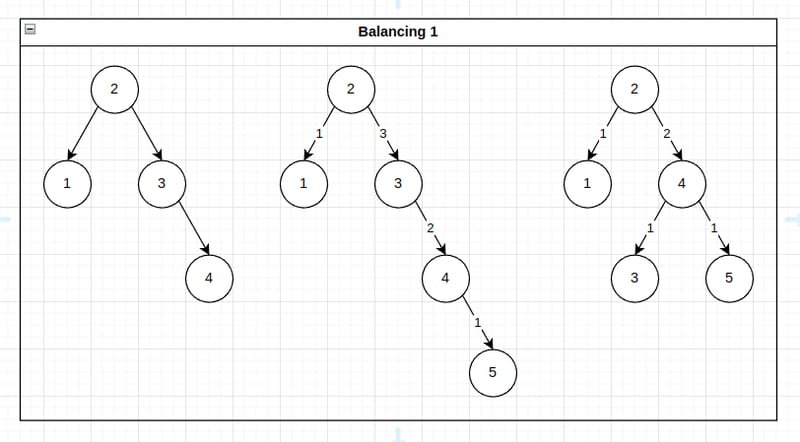
If we have a balance factor equal 2, and the balance factor of our right child is negative, we have to apply right rotation for our right child and after left rotation for the current vertex.
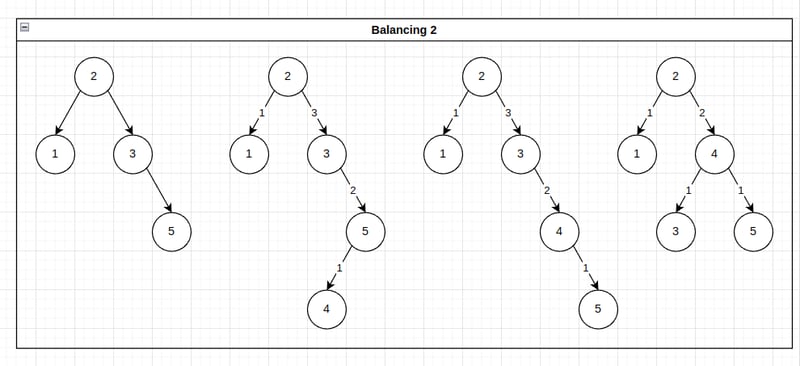
Same procedure for left subtree.
If we have a balance factor equal -2, this means our left subtree is too long. We have to apply the right rotation.
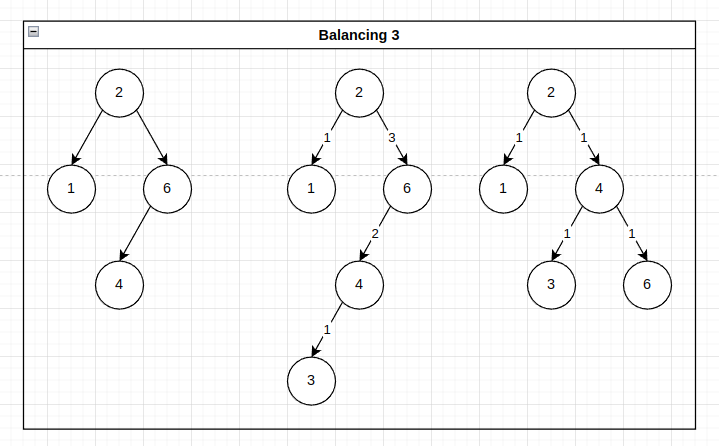
If we have a balance factor equal -2, and the balance factor of our left child is positive, we have to apply left rotation for our left child and after right rotation for the current vertex.
Removing
If the current node less that value we will look in the left subtree.
If the current node is bigger that value we will look in the right subtree.
There are two cases here:
Node has no right subtree, we have to replace the current vertex to the left child.
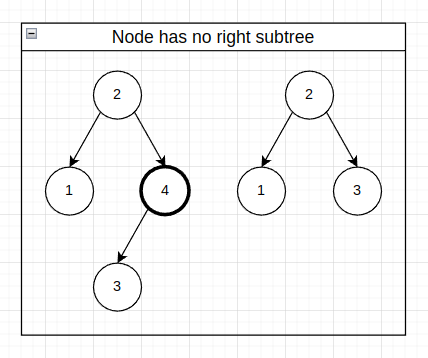
Node has a right subtree. We have to find the minimum value in the right subtree, to change the current vertex. After changing vertices we need to remove a minimum value from the right subtree.
Code for tree
class AvlTree {
constructor() {
this.root = undefined;
}
/**
* Left rotation
* 1) Right child became new root
* 2) Node lose right child, and left child of old right child became new right child of the node
* 3) Old right child lose left child, and node became new left child of the new root
* @param {object} node
* @returns {object}
*/
rotateLeft(node) {
const root = node.right;
const left = node;
left.right = root.left;
root.left = left;
left.fixHeight();
root.fixHeight();
return root;
}
/**
* Right rotation
* 1) Left child became new root
* 2) Node lose left child, and right child of old left child became new left child of the node
* 3) Old left child lose right child, and node became new right child of the new root
* @param {object} node
* @returns {object}
*/
rotateRight(node) {
const root = node.left;
const right = node;
right.left = root.right;
root.right = right;
right.fixHeight();
root.fixHeight();
return root;
}
/**
* AVL trees have a balancing factor. This calculates the difference between height of a right subtree and height of a left subtree.
* There are 4 cases for balancing.
* If we have a balance factor equal 2, this means the right subtree is too long, we have to apply left rotation.
* If we have a balance factor equal 2, and the balance factor of our right child is negative.
* We have to apply right rotation for our right child and after left rotation for the current vertex.
* Same procedure for left subtree.
* If we have a balance factor equal -2, this means our left subtree is too long. We have to apply the right rotation.
* If we have a balance factor equal -2, and the balance factor of our left child is positive.
* We have to apply left rotation for our left child and after right rotation for the current vertex.
* @param {object} node
* @returns {object}
*/
balance(node) {
node.fixHeight();
if (node.getBalanceFactor() === 2 ) {
if (node.right.getBalanceFactor() < 0) {
node.right = this.rotateRight(node.right);
}
return this.rotateLeft(node);
}
if (node.getBalanceFactor() === -2) {
if (node.left.getBalanceFactor() > 0) {
node.left = this.rotateLeft(node.left);
}
return this.rotateRight(node);
}
return node;
}
insert(node) {
if (! this.root) {
this.root = node;
return;
}
this.root = this._insert(this.root, node);
}
/**
* Insertion of new node
* If node less that current node we need to insert in left child
* If node value bigger that current node we need to insert in right child
* After insertion of a new node, we should restore balance. Method of balancing works from new node to root for all subtrees by recursion.
* @param {object} vertex - vertex of the tree
* @param {object} node - new node
*/
_insert(vertex, node) {
if (node.key === vertex.key) {
return vertex;
}
if (node.key < vertex.key) {
if (! vertex.left) {
vertex.left = node;
} else {
vertex.left = this._insert(vertex.left, node);
}
} else {
if (! vertex.right) {
vertex.right = node;
} else {
vertex.right = this._insert(vertex.right, node);
}
}
return this.balance(vertex);
}
findMin(node) {
return node.left ? this.findMin(node.left) : node;
}
/**
* Removing a minimum in subtree.
* If a vertex has no left child, we replace the current vertex by the right child.
*
* If a vertex has a left child we apply a function for the left child.
* If a left child has a right child this will be replaced. If a left child has no children this will be replaced by undefined, removed.
*
* @param {object} node
* @returns {object}
*/
removeMin(node) {
if (! node.left) {
return node.right;
}
node.left = this.removeMin(node.left);
return this.balance(node);
}
remove(k) {
this.root = this._remove(this.root, k);
return this.root;
}
/**
* Removing a node. This is a recursive function.
* If the current node less that value we will look in the left subtree.
* If the current node is bigger that value we will look in the right subtree.
*
* There are two cases here:
* Node has no right subtree, we have to replace the current vertex to the left child.
*
* Node has a right subtree. We have to find the minimum value in the right subtree, to change the current vertex.
* After changing vertices we need to remove a minimum value from the right subtree.
* @param {object} node - current vertex of the tree
* @param {number} k - value for remove
* @returns {object|undefined}
*/
_remove(node, k) {
if (! node) {
return;
}
if (k < node.key) {
node.left = this._remove(node.left, k);
} else if (k > node.key) {
node.right = this._remove(node.right, k);
} else {
if (! node.right) {
return node.left;
}
const min = this.findMin(node.right);
node.key = min.key;
node.right = this.removeMin(node.right);
node = this.balance(node);
}
return node;
}
find(k, node) {
if (! node) {
node = this.root;
}
if (k === node.key) {
return node;
} else if (k < node.key) {
if (! node.left) {
return;
}
return this.find(k, node.left);
} else if (k > node.key) {
if (! node.right) {
return;
}
return this.find(k, node.right);
}
}
}
Example
const printTree = (binaryTree) => {
const layers = [];
const queue = [
{
node: binaryTree.root,
layer: 0,
}
];
while (queue.length) {
const { node, layer, parent } = queue.shift();
layers[layer] = layers[layer] || [];
layers[layer].push(`${node.key}(${parent || ''})`);
if (node.left) {
queue.push({
node: node.left,
layer: layer + 1,
parent: node.key + ':l',
});
}
if (node.right) {
queue.push({
node: node.right,
layer: layer + 1,
parent: node.key + ':r'
});
}
}
for (let i = 0; i < layers.length; ++i) {
const layer = layers[i];
const tabs = new Array(layers.length - i).fill(' ').join('');
const str = layer.join(' ');
console.log(tabs + str + '\n');
}
}
const main = () => {
const avl = new AvlTree();
for (let i = 1; i < 11; ++i) {
const n = new Node({ key: i });
avl.insert(n);
}
printTree(avl);
avl.insert(new Node({key: 11}));
printTree(avl);
avl.remove(10);
printTree(avl);
};
main();

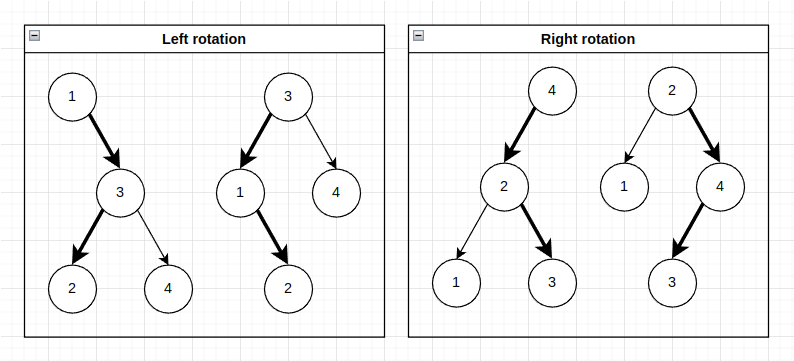
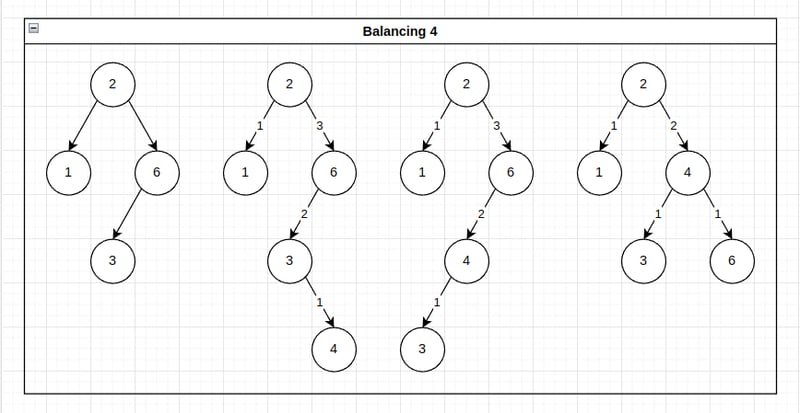
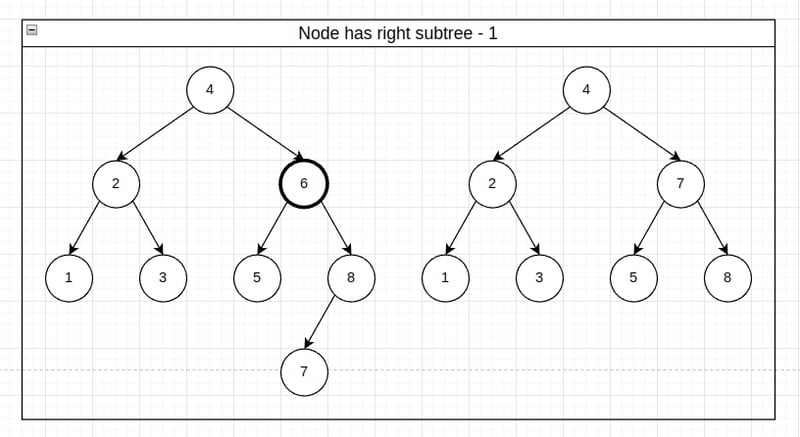
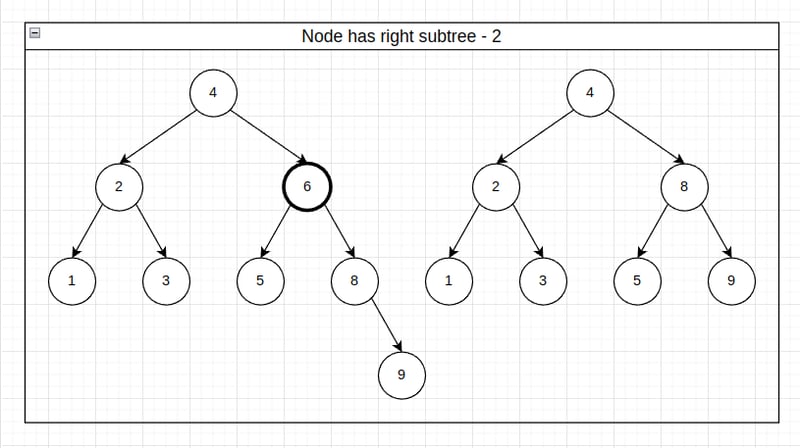





Top comments (0)